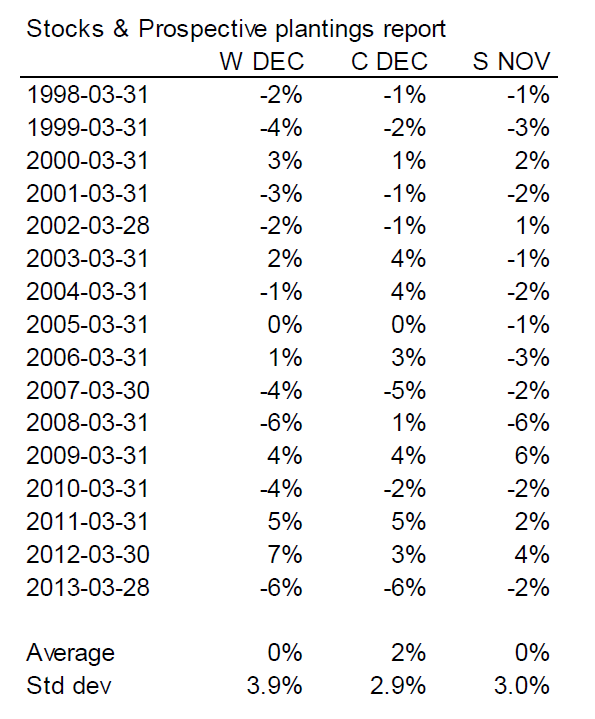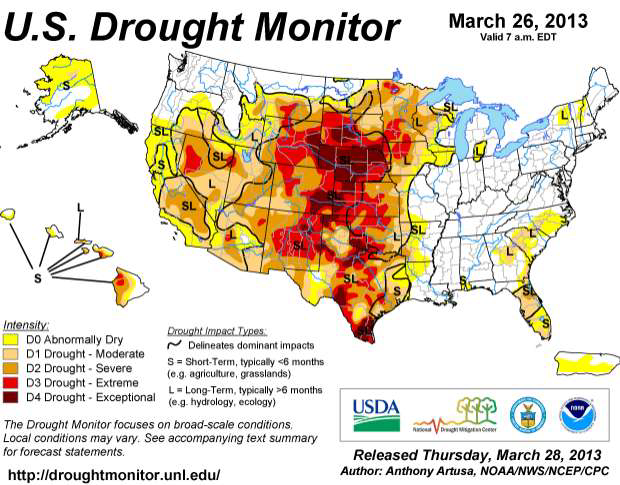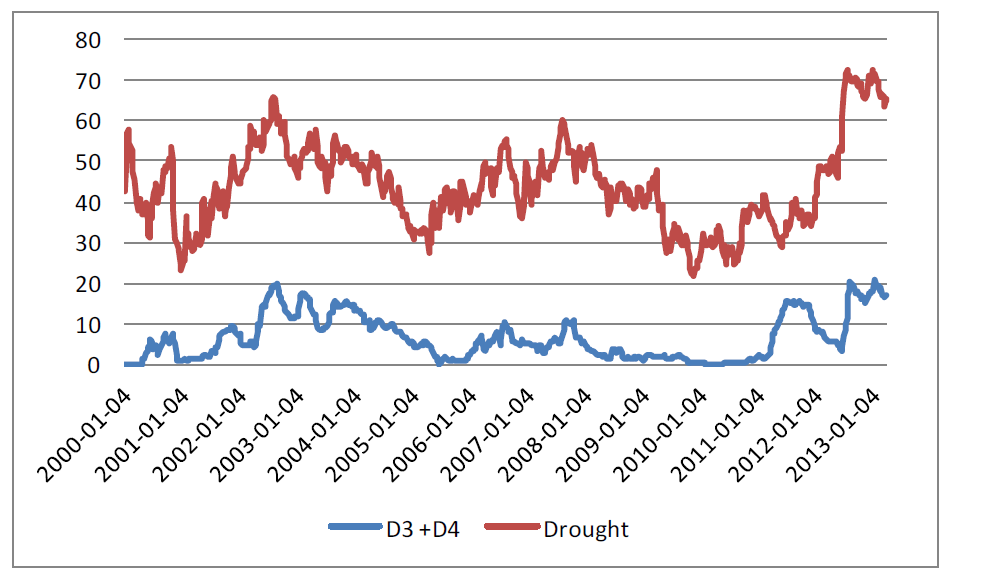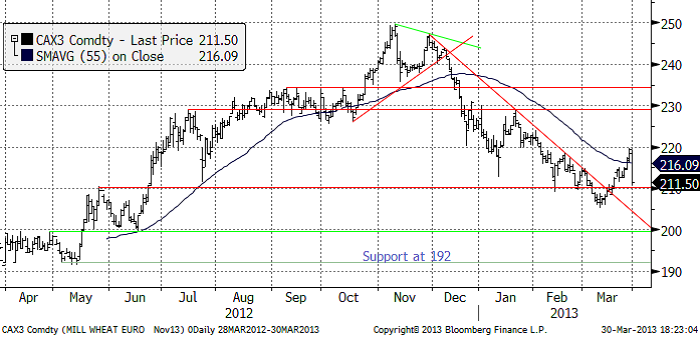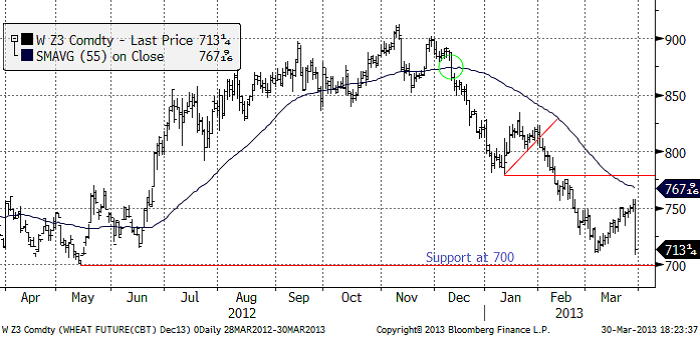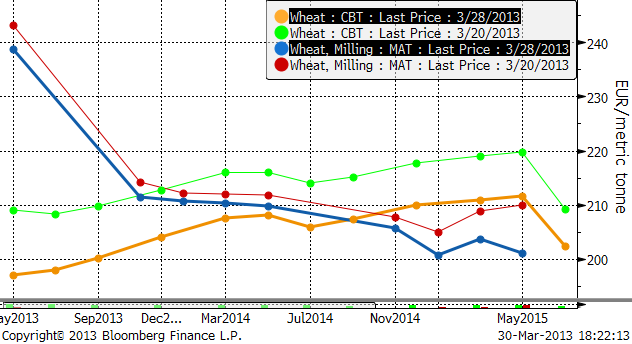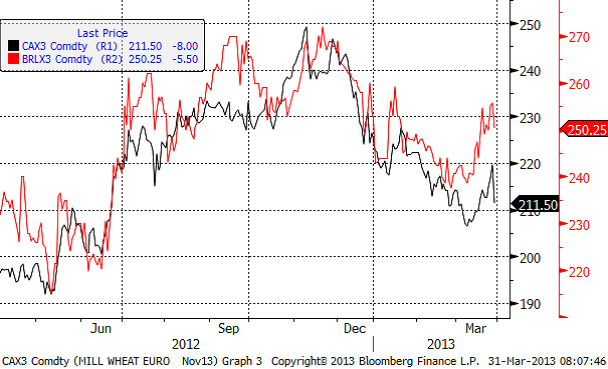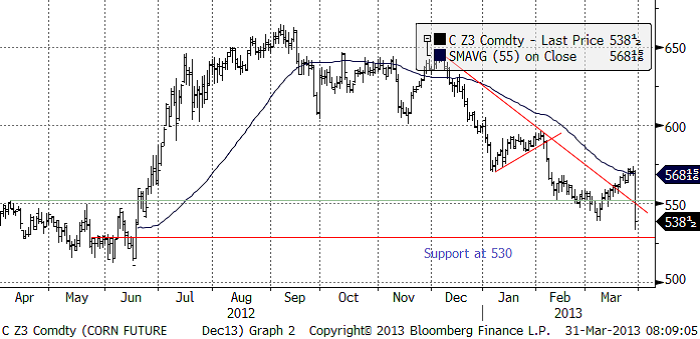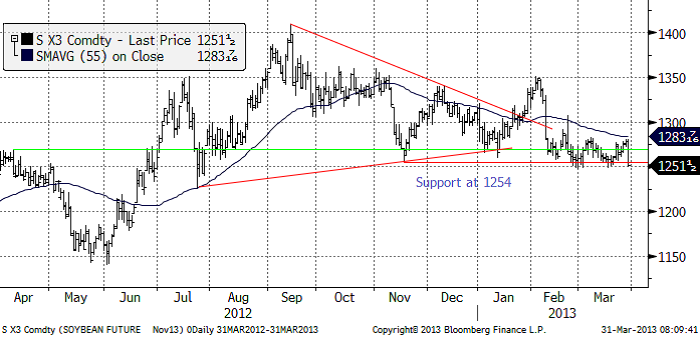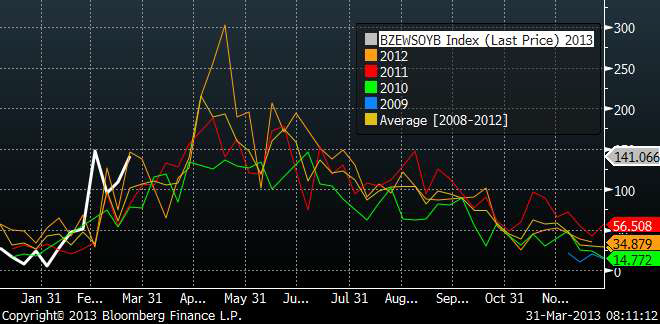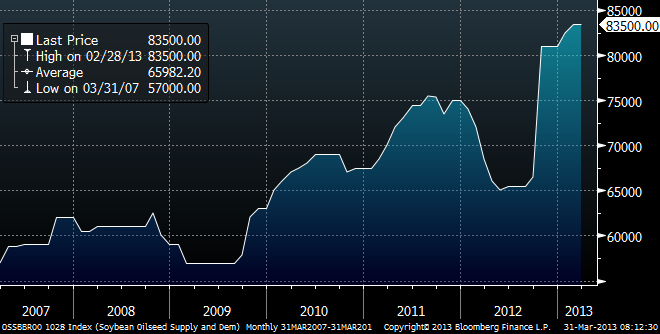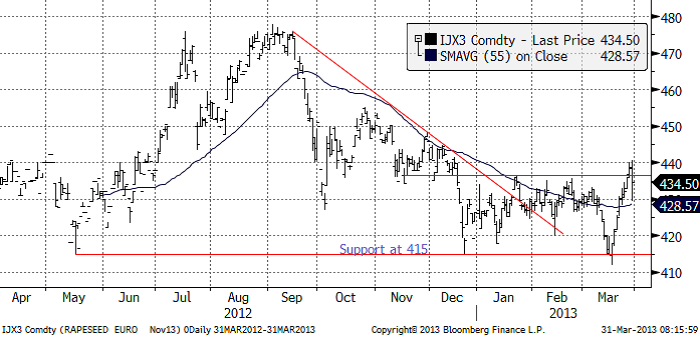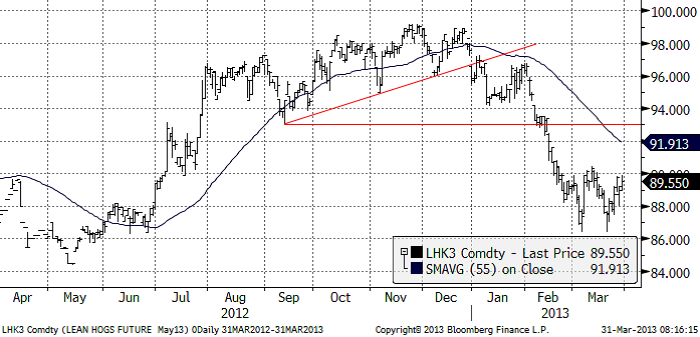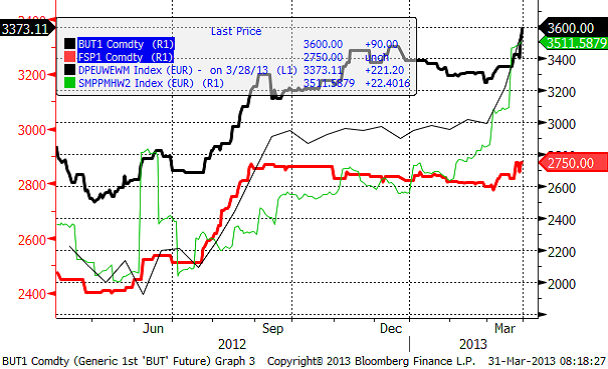Analys
SEB Jordbruksprodukter, 31 mars 2013
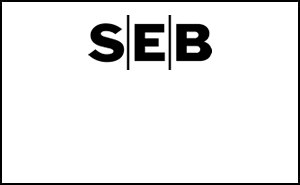
 Lagerstatistiken och den tillhörande odlade arealen i USA var ultrabaissiga. Priserna på majs stängde limit-down. Vete och sojabönor föll kraftigt de också. Pristrenden kommer att gå nedåt härifrån.
Lagerstatistiken och den tillhörande odlade arealen i USA var ultrabaissiga. Priserna på majs stängde limit-down. Vete och sojabönor föll kraftigt de också. Pristrenden kommer att gå nedåt härifrån.
Marknadens missbedömning var en av de största någonsin och marknadsrörelsen på Skärtorsdagen en av de största någonsin, i majs bara dämpad av den största tillåtna prisrörelsen.
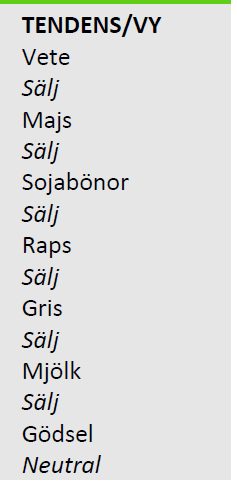 Sådden av majs väntas ske på 97.3 miljoner acres, något över marknadens förväntningar. Det är den största arealen sedan 1936.
Sådden av majs väntas ske på 97.3 miljoner acres, något över marknadens förväntningar. Det är den största arealen sedan 1936.
De amerikanska börserna var stängda på Långfredagen, men är öppna på Annandag Påsk. Europa är dock stängt och öppnar först på tisdag. Vi kan förvänta oss betydligt lägre priser på tisdag.
Läsaren kanske kommer ihåg att jag här förra veckan skrev att den rekyl uppåt som vi sett fram till i torsdags, var ett bra tillfälle för lantbrukare att prissäkra. Jag skrev också att risk / reward var på nedsidan, eftersom de senaste rapporterna lett till uppgångar. Nu tänker förmodligen många att ”det är för sent” att prissäkra. I synnerhet som priserna kommer stå ännu lägre på tisdag när Europa öppnar. Att inte prissäkra på tisdag tror jag är ett misstag. Det kommer säkerligen att gå nedåt härifrån. Låt inte ett misstag bli ett misslyckande.
Vi går över till säljrekommendation på alla grödor.
Stocks & Plantings – rapporten i siffror
Lagren av vete, majs och sojabönor var per den 1 mars betydligt högre än vad marknaden förväntat sig, som vi ser i tabellen nedan.
Lagerestimaten år så stora att man undrar om det inte var fel – för låga siffror i decemberrapporten, eller om lagren nu möjligtvis är för stora. Om marknaden tror på siffrorna, och det gör den med all säkerhet, så finns knappast längre någon anledning till oro för att det är kallt och sådden blivit försenad. Vad gäller sojabönor försvann också oron för att sojabönorna ska ta slut i USA innan Brasilien får ut sina.
Sådd areal, som vi ser nedan hade marknadens analytiker bättre koll på, utom för vårvete och durum. Men vi vet redan tidigare att sådden väntas bli mycket stor i år.
Nedan ser vi prisförändringarna på de senaste årens rapportdagar. Prisreaktionen är uppmätt i respektive års decemberkontrakt för vete och majs och november för sojabönor.
Var hittar man terminspriser på nätet?
Den vanligaste frågan jag får via email från läsare av mitt veckobrev eller marknadskommentaren på ATL.nu är var man kan följa priserna på terminer på nätet. Oftast är det självklaraste svaret att man ska besöka respektive börs hemsida. Börserna publicerar priser som är fördröjda med 15 minuter. Besöker man den tyska börsen Eurex hittar man efter lite letande vad man söker. Men besöker man den franska börsen Matif (som nu är en del av New York Stock Exchange) hittar man det inte. Sidan är också en blandning av franska och engelska.
Ett betydligt bättre sätt är att besöka www.barchart.com.
Jag har än så länge inte sökt något där som jag inte hittat. För enkelhets skull har jag listat svaren på de vanligaste frågorna nedan:
Kvarnvete på Matif
www.barchart.com/commodityfutures/Matif_Milling_Wheat_Futures/MLX11
Raps på Matif
www.barchart.com/commodityfutures/Matif_Rapeseed_Futures/XR
Smör på Eurex
www.barchart.com/commodityfutures/Eurex_Butter_Futures/QYH13
SMP på Eurex
www.barchart.com/commodityfutures/Eurex_Skimmed_Milk_Futures/MRN13
Priserna är fördröjda med 15 minuter. Det duger väldigt väl för att följa med i marknaden och är vad de allra flesta har ändå. Realtidspriser kostar så mycket att bara traders och kundhandlare på bankerna har dem. När det är skarpt läge och man vill handla på telefon kan man få priserna av dem.
Odlingsväder
Det har inte varit några stora förändringar i klimatet i USA. Det är fortsatt torrt.
I siffrorna för torkan ser vi att det inte heller där märks av någon skillnad.
Vete
Priset på november (2013) hann falla ner till 211.50 i torsdags innan marknaden föll. Det var lite handel vid femtiden, men sedan hade handlarna på spannmålsfirmorna gått hem och tagit helg de också. Tekniskt ser vi att 210 är en viktig stödnivå. Den lär brytas på tisdag med 200 som nästa stödnivå.
Decemberkontraktet på CBOT föll ner till botten på nedgången från december. Den nivån kommer säkert att testas på måndag och förmodligen brytas. 700 cent är en viktig nivå att hålla koll på. Bryts även den nivån, öppnas för ytterligare prisfall.
Terminskurvorna (alla i euro / ton) visar att prisfallet varit mycket kraftigare i USA och att lagerstatistiken påverkade alla löptider även för leverans långt bort i tiden. Lagren satt som en propp i marknaden. Matif hann inte alls falla lika mycket i torsdags och har en del ”catch up” att göra på tisdag.
Crop condition för vintervetet i USA börjar publiceras på måndag klockan 22:00. Den senaste uppdateringen är från den 23 november förra året. Då var 33% i good / excellent condition.
Möjligen kan man tänka sig att en ny siffra, som förmodligen inte är sådär fantastiskt bra, kan få vetemarknaden att rekylera uppåt på tisdag. En sådan uppgång kan förmodligen vara ett bra tillfälle att sälja på.
Vi har säljrekommendation på vete.
Maltkorn
Priset på maltkorn med leverans i november har fortsatt att ligga högre än kvarnvetet på Matif. Eftersom maltkorn är en så pass illikvid terminsmarknad reagerade inte priserna på torsdagens rapport. Förmodligen gjordes inget avslut efter 17:00, men jag har inte kollat i detalj. Vi ser att när priset på maltkorn dragit ifrån, som nu, har det alltid återvänt till sin stadiga ”spread” till kvarnvetet. Maltkornet är just nu särskilt säljvärt, mer så än kvarnvetet.
Vi har säljrekommendation på maltkorn.
Majs
Majspriset (december 2013) föll kraftigt, som vi redan nämnt. Lagerrapporten var ultranegativ för majsen. Priset föll förbi botten från nedgången från december, men stängde pga limit-down stopp i handeln över stödet på 530 cent. Den nivån kommer naturligtvis att testas på måndag. På måndag är dessutom största tillåtna prisrörelse utökad eftersom torsdagen stängde limit down.
Som nämnt ovan är arealen sådd med majs den största i USA sedan 1936. Sådden är igång i södra USA. Det kommer att bli väldigt gott om majs i år, om det inte blir en ny tork-katastrof. Vi går över till säljrekommendation på majs.
Sojabönor
Sojabönorna (november 2013) gick genom stödet på 1254, då lagren visade att USA INTE har någon brist på sojabönor. Möjligen kan detta ifrågasättas, eftersom export inspections har legat tidigt i säsongen – började öka tidigt och började falla tidigt. Det är viktigt för en kort position att priset faller genom stödet på 1250 också och för det behövs bara 2 cent.
Marknaden har i flera veckor ojat sig över att lastningen i hamnarna i Brasilien tar så lång tid. Regnigt väder och arbetslagstiftning är två av orsakerna. En annan är att själva storleken på skörden. Det är flera miljoner ton mer sojabönor som ska exporteras. Om vi tänker på hur våra hamnar i Sverige, Danmark eller Tyskland skulle reagera på några miljoner ton extra att hantera, kanske man får lättare att förstå att det kan bli kö på fartygen.
Nedan ser vi Brasiliens export av sojabönor i miljoner dollar FOB. Diagrammet visar de olika kalenderåren. Vi ser att årets export kom igång sent. Säkerligen kommer den vita kurvan att hamna på rekordnivåer senare i år.
Ser vi till skörden av sojabönor i USA, ser vi att det i förhållande till förra året är nästan 20 miljoner ton mer!!!
Det är alltså inte konstigt att det är ett problem med sojabönorna i hamnarna i Brasilien. Problemet har varit mycket regn, framförallt, men det stora problemet är skördens och exportens enorma storlek. Det är knappast något som motiverar att priset ska stiga. Snarare tvärtom. Vi går över till säljrekommendation på sojabönor.
Raps
Rapspriset (november 2013) som gick upp och rörde vid 440 euro per ton, följde med sojabönorna ner. Nu kommer priset med största sannolikhet att ge tillbaka vinsterna till marknaden och falla ner mot stödet på 415 euro igen. Vi går nu åter till säljrekommendation på raps.
Gris
Grispriset (Maj 13) har stabiliserat sig mellan 86 och 90 cent. Det är för tidigt att säga om det här är en konsolidering för en rekyl uppåt, eller en paus inför ytterligare en nedgång.
Mjölk
I kursdiagrammet nedan ser vi fyra kurvor.
BUT1 = priset på det kortaste terminskontraktet på Eurex, på smör.
FSP1 = priset på det kortaste terminskontraktet på Eurex, på SMP.
DPEUWEWM = USDA:s notering på SMP FOB Western Europe.
SMPPMHW2 = Fonterra’s auktionspris på SMP.
Priset på SMP har rusat och USDA:s notering på europeiska SMP-priser har följt med. Priset på SMP på Eurex har inte följt med, utan ligger på samma nivå som i september och oktober. Terminspriset på smör har däremot handlats upp och ligger nu på all-time-high.
SEB Commodities erbjuder ett litet ”prova-på” kontrakt som består av 0.5 ton Eurex-smör och 0.9 ton Eurex SMP. Ett paket som motsvarar 10 ton flytande mjölkråvara. Just nu är det underliggande värdet på ett sådant kontrakt drygt 33 000 kronor.
Den som vill följa priset på SMP på Eurex gör det via länken:
www.eurexchange.com/exchange-en/products/com/agr/14016/
[box]SEB Veckobrev Jordbruksprodukter är producerat av SEB Merchant Banking och publiceras i samarbete och med tillstånd på Råvarumarknaden.se[/box]
Disclaimer
The information in this document has been compiled by SEB Merchant Banking, a division within Skandinaviska Enskilda Banken AB (publ) (“SEB”).
Opinions contained in this report represent the bank’s present opinion only and are subject to change without notice. All information contained in this report has been compiled in good faith from sources believed to be reliable. However, no representation or warranty, expressed or implied, is made with respect to the completeness or accuracy of its contents and the information is not to be relied upon as authoritative. Anyone considering taking actions based upon the content of this document is urged to base his or her investment decisions upon such investigations as he or she deems necessary. This document is being provided as information only, and no specific actions are being solicited as a result of it; to the extent permitted by law, no liability whatsoever is accepted for any direct or consequential loss arising from use of this document or its contents.
About SEB
SEB is a public company incorporated in Stockholm, Sweden, with limited liability. It is a participant at major Nordic and other European Regulated Markets and Multilateral Trading Facilities (as well as some non-European equivalent markets) for trading in financial instruments, such as markets operated by NASDAQ OMX, NYSE Euronext, London Stock Exchange, Deutsche Börse, Swiss Exchanges, Turquoise and Chi-X. SEB is authorized and regulated by Finansinspektionen in Sweden; it is authorized and subject to limited regulation by the Financial Services Authority for the conduct of designated investment business in the UK, and is subject to the provisions of relevant regulators in all other jurisdictions where SEB conducts operations. SEB Merchant Banking. All rights reserved.
Analys
Tightening fundamentals – bullish inventories from DOE

The latest weekly report from the US DOE showed a substantial drawdown across key petroleum categories, adding more upside potential to the fundamental picture.

Commercial crude inventories (excl. SPR) fell by 5.8 million barrels, bringing total inventories down to 415.1 million barrels. Now sitting 11% below the five-year seasonal norm and placed in the lowest 2015-2022 range (see picture below).
Product inventories also tightened further last week. Gasoline inventories declined by 2.1 million barrels, with reductions seen in both finished gasoline and blending components. Current gasoline levels are about 3% below the five-year average for this time of year.
Among products, the most notable move came in diesel, where inventories dropped by almost 4.1 million barrels, deepening the deficit to around 20% below seasonal norms – continuing to underscore the persistent supply tightness in diesel markets.
The only area of inventory growth was in propane/propylene, which posted a significant 5.1-million-barrel build and now stands 9% above the five-year average.
Total commercial petroleum inventories (crude plus refined products) declined by 4.2 million barrels on the week, reinforcing the overall tightening of US crude and products.


Analys
Bombs to ”ceasefire” in hours – Brent below $70

A classic case of “buy the rumor, sell the news” played out in oil markets, as Brent crude has dropped sharply – down nearly USD 10 per barrel since yesterday evening – following Iran’s retaliatory strike on a U.S. air base in Qatar. The immediate reaction was: “That was it?” The strike followed a carefully calibrated, non-escalatory playbook, avoiding direct threats to energy infrastructure or disruption of shipping through the Strait of Hormuz – thus calming worst-case fears.

After Monday morning’s sharp spike to USD 81.4 per barrel, triggered by the U.S. bombing of Iranian nuclear facilities, oil prices drifted sideways in anticipation of a potential Iranian response. That response came with advance warning and caused limited physical damage. Early this morning, both the U.S. President and Iranian state media announced a ceasefire, effectively placing a lid on the immediate conflict risk – at least for now.
As a result, Brent crude has now fallen by a total of USD 12 from Monday’s peak, currently trading around USD 69 per barrel.
Looking beyond geopolitics, the market will now shift its focus to the upcoming OPEC+ meeting in early July. Saudi Arabia’s decision to increase output earlier this year – despite falling prices – has drawn renewed attention considering recent developments. Some suggest this was a response to U.S. pressure to offset potential Iranian supply losses.
However, consensus is that the move was driven more by internal OPEC+ dynamics. After years of curbing production to support prices, Riyadh had grown frustrated with quota-busting by several members (notably Kazakhstan). With Saudi Arabia cutting up to 2 million barrels per day – roughly 2% of global supply – returns were diminishing, and the risk of losing market share was rising. The production increase is widely seen as an effort to reassert leadership and restore discipline within the group.
That said, the FT recently stated that, the Saudis remain wary of past missteps. In 2018, Riyadh ramped up output at Trump’s request ahead of Iran sanctions, only to see prices collapse when the U.S. granted broad waivers – triggering oversupply. Officials have reportedly made it clear they don’t intend to repeat that mistake.
The recent visit by President Trump to Saudi Arabia, which included agreements on AI, defense, and nuclear cooperation, suggests a broader strategic alignment. This has fueled speculation about a quiet “pump-for-politics” deal behind recent production moves.
Looking ahead, oil prices have now retraced the entire rally sparked by the June 13 Israel–Iran escalation. This retreat provides more political and policy space for both the U.S. and Saudi Arabia. Specifically, it makes it easier for Riyadh to scale back its three recent production hikes of 411,000 barrels each, potentially returning to more moderate increases of 137,000 barrels for August and September.
In short: with no major loss of Iranian supply to the market, OPEC+ – led by Saudi Arabia – no longer needs to compensate for a disruption that hasn’t materialized, especially not to please the U.S. at the cost of its own market strategy. As the Saudis themselves have signaled, they are unlikely to repeat previous mistakes.
Conclusion: With Brent now in the high USD 60s, buying oil looks fundamentally justified. The geopolitical premium has deflated, but tensions between Israel and Iran remain unresolved – and the risk of missteps and renewed escalation still lingers. In fact, even this morning, reports have emerged of renewed missile fire despite the declared “truce.” The path forward may be calmer – but it is far from stable.
Analys
A muted price reaction. Market looks relaxed, but it is still on edge waiting for what Iran will do

Brent crossed the 80-line this morning but quickly fell back assigning limited probability for Iran choosing to close the Strait of Hormuz. Brent traded in a range of USD 70.56 – 79.04/b last week as the market fluctuated between ”Iran wants a deal” and ”US is about to attack Iran”. At the end of the week though, Donald Trump managed to convince markets (and probably also Iran) that he would make a decision within two weeks. I.e. no imminent attack. Previously when when he has talked about ”making a decision within two weeks” he has often ended up doing nothing in the end. The oil market relaxed as a result and the week ended at USD 77.01/b which is just USD 6/b above the year to date average of USD 71/b.

Brent jumped to USD 81.4/b this morning, the highest since mid-January, but then quickly fell back to a current price of USD 78.2/b which is only up 1.5% versus the close on Friday. As such the market is pricing a fairly low probability that Iran will actually close the Strait of Hormuz. Probably because it will hurt Iranian oil exports as well as the global oil market.
It was however all smoke and mirrors. Deception. The US attacked Iran on Saturday. The attack involved 125 warplanes, submarines and surface warships and 14 bunker buster bombs were dropped on Iranian nuclear sites including Fordow, Natanz and Isfahan. In response the Iranian Parliament voted in support of closing the Strait of Hormuz where some 17 mb of crude and products is transported to the global market every day plus significant volumes of LNG. This is however merely an advise to the Supreme leader Ayatollah Ali Khamenei and the Supreme National Security Council which sits with the final and actual decision.
No supply of oil is lost yet. It is about the risk of Iran closing the Strait of Hormuz or not. So far not a single drop of oil supply has been lost to the global market. The price at the moment is all about the assessed risk of loss of supply. Will Iran choose to choke of the Strait of Hormuz or not? That is the big question. It would be painful for US consumers, for Donald Trump’s voter base, for the global economy but also for Iran and its population which relies on oil exports and income from selling oil out of that Strait as well. As such it is not a no-brainer choice for Iran to close the Strait for oil exports. And looking at the il price this morning it is clear that the oil market doesn’t assign a very high probability of it happening. It is however probably well within the capability of Iran to close the Strait off with rockets, mines, air-drones and possibly sea-drones. Just look at how Ukraine has been able to control and damage the Russian Black Sea fleet.
What to do about the highly enriched uranium which has gone missing? While the US and Israel can celebrate their destruction of Iranian nuclear facilities they are also scratching their heads over what to do with the lost Iranian nuclear material. Iran had 408 kg of highly enriched uranium (IAEA). Almost weapons grade. Enough for some 10 nuclear warheads. It seems to have been transported out of Fordow before the attack this weekend.
The market is still on edge. USD 80-something/b seems sensible while we wait. The oil market reaction to this weekend’s events is very muted so far. The market is still on edge awaiting what Iran will do. Because Iran will do something. But what and when? An oil price of 80-something seems like a sensible level until something do happen.
-

 Nyheter4 veckor sedan
Nyheter4 veckor sedanStor uppsida i Lappland Guldprospekterings aktie enligt analys
-

 Nyheter4 veckor sedan
Nyheter4 veckor sedanSilverpriset släpar efter guldets utveckling, har mer uppsida
-

 Nyheter3 veckor sedan
Nyheter3 veckor sedanUppgången i oljepriset planade ut under helgen
-

 Nyheter3 veckor sedan
Nyheter3 veckor sedanLåga elpriser i sommar – men mellersta Sverige får en ökning
-

 Nyheter2 veckor sedan
Nyheter2 veckor sedanMahvie Minerals växlar spår – satsar fullt ut på guld
-

 Analys3 veckor sedan
Analys3 veckor sedanVery relaxed at USD 75/b. Risk barometer will likely fluctuate to higher levels with Brent into the 80ies or higher coming 2-3 weeks
-

 Nyheter1 vecka sedan
Nyheter1 vecka sedanOljan, guldet och marknadens oroande tystnad
-

 Nyheter1 vecka sedan
Nyheter1 vecka sedanJonas Lindvall är tillbaka med ett nytt oljebolag, Perthro, som ska börsnoteras




